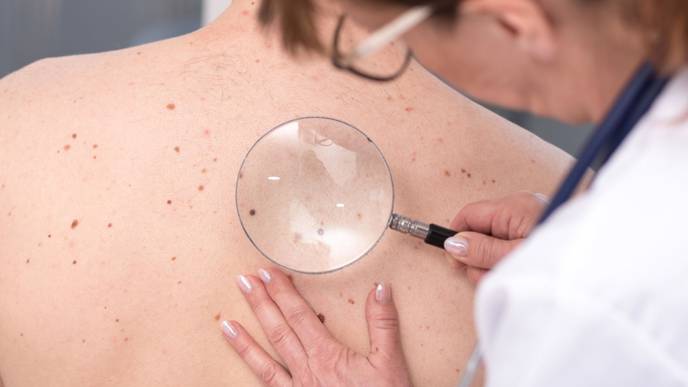ReachMD
Be part of the knowledge.™Better Melanoma Follow-Up Adherence May Reduce Melanoma-Specific Mortality

In the setting of primary cutaneous melanoma, better adherence to annual dermatology follow-up visits was associated with reduced melanoma-specific mortality, according to study findings published in the Journal of the American Academy of Dermatology.
While different melanoma care guidelines universally advocate for dermatology follow-up, there is considerable variation in the recommended surveillance frequency and duration.
In a retrospective, population-based observational cohort study, investigators aimed to characterize the level of annual dermatologic follow-up adherence among patients with primary cutaneous melanoma, identify predictors of better adherence in these patients, and evaluate the relationship between adherence and melanoma-related mortality.
Using the Ontario Cancer Registry database, which captures 88.8% to approximately 94.0% of annual incident melanomas in the province of Ontario, Canada, the investigators gathered relevant data from adults diagnosed with their first invasive cutaneous melanoma between January 2010 through December 2013 and followed up through December 2018. Eligible patients were followed until 5 years after diagnosis, loss of health insurance coverage, or mortality, whichever occurred first.
“
Higher cumulative adherence over time was associated with significantly lower melanoma-specific mortality in our study, underscoring the importance of promoting continuous adherence throughout follow-up.
The study included 10,084 adults with a total of 46,386 person-years of follow-up. Patients were a median age of 63 (IQR, 51.0 to 75.0) years and more than half (53.1%) were men. Melanoma stage at diagnosis was primarily (60.7%) stage I or II. In 29.5% of patients, the stage was unknown. Approximately one-fifth (19.2%) of patients had a history of keratinocyte carcinoma. Almost half (49.9%) of patients were in the 2 highest income quintiles of the cohort and 83.5% lived in an urban community, which was used as proxy for better access to care. Overall, patients spent a median of 5 years in follow-up.
Only 28% of patients achieved full adherence to annual dermatologic follow-up, while 26.9% never visited a dermatologist during the follow-up period. Complete adherence vs total lack of adherence varied by disease stage: among patients with stage I melanoma, 28.1% were fully adherent and 25.6% were never adherent. Among those with stage II melanoma, 26.4% were fully adherent and 30.8% were never adherent. Among those with stage III, 31.8% were fully adherent and 23.8% were never adherent. Among patients with stage IV, 25.8% were fully adherent and 42.4% were never adherent.
Overall, 5466 patients adhered to annual dermatologic follow-up less than 75% of the time and 4618 patients adhered more than 75% of the time. Specific cohort characteristics that may have been associated with better adherence to annual follow-up visits included being in the highest income quintile (31.5% vs 23.9%, respectively), urban residence (88.1% vs 79.6%, respectively), history of squamous cell carcinoma in situ (23.4% vs 15.6%, respectively), and history of keratinocyte carcinoma (23.4% vs 15.6%, respectively).
Univariable and multivariable models showed predictors of better adherence to be younger age, female sex, higher income, greater access to dermatology care, stage 2 or 3 melanoma at diagnosis, prior keratinocyte carcinoma, fewer comorbidities, and any outpatient visit in the 12 months prior to melanoma diagnosis. Patients older than 75 years had half the adjusted adherence rate of patients aged 18 to 34 years (adjusted relative rate [aRR], 0.46; 95% CI, 0.39-0.55). Prior outpatient visits with a dermatologist or other physician were associated with increased adherence rates compared with no prior visits (aRR, 2.84; 95% CI, 2.59-3.11). Patients with a Charlson comorbidity score of at least 2 (aRR, 0.76; 95% CI, 0.62-0.92) or recent hospitalization (aRR, 0.76, 95% CI, 0.65 to 0.88) had lower adherence rates than patients with no hospitalization.
Compared with lower levels of adherence, greater adherence was associated with reduced melanoma-specific mortality (adjusted hazard ratio [aHR], 0.64; 95% CI, 0.52-0.78). In an exploratory analysis stratifying results based on melanoma stage, a statistically significant mortality reduction associated with adherence to follow-up visits at least 75% of the time was observed in patients with stage I to III melanoma (aHR, 0.61; 95% CI, 0.49-0.75) but not in those with stage IV melanoma (aHR, 1.58; 95% CI, 0.71-3.55).
In addition, sensitivity analyses evaluating adherence to 3- and 6-month follow-up intervals uncovered similar trends; compared with results of annual visit adherence, better cumulative adherence to follow-up at these shorter intervals was associated with even greater increases in melanoma survival.
Sensitivity analyses that included use of systemic therapy for metastasis as a time-varying covariate did not change the effect estimate for the association between melanoma mortality and adherence to follow-up visits.
Limitations of this study include its observational design, which is susceptible to bias and cannot prove causation; the inability to identify nondermatologist-conducted follow-up skin examinations; the lack of stage data for 30% of patients, likely reflecting early-stage tumors treated in the community; and lack of effective systemic therapy during earlier years of the study period.
The investigators concluded, “Higher cumulative adherence over time was associated with significantly lower melanoma-specific mortality in our study, underscoring the importance of promoting continuous adherence throughout follow-up.” They added, “Patients, health care providers, and policy makers should explore opportunities to improve adherence within the constraints of healthcare systems.”
Disclosure: Some study authors declared affiliations with biotech, pharmaceutical, and/or device companies. Please see the original reference for a full list of authors’ disclosures.
Facebook Comments